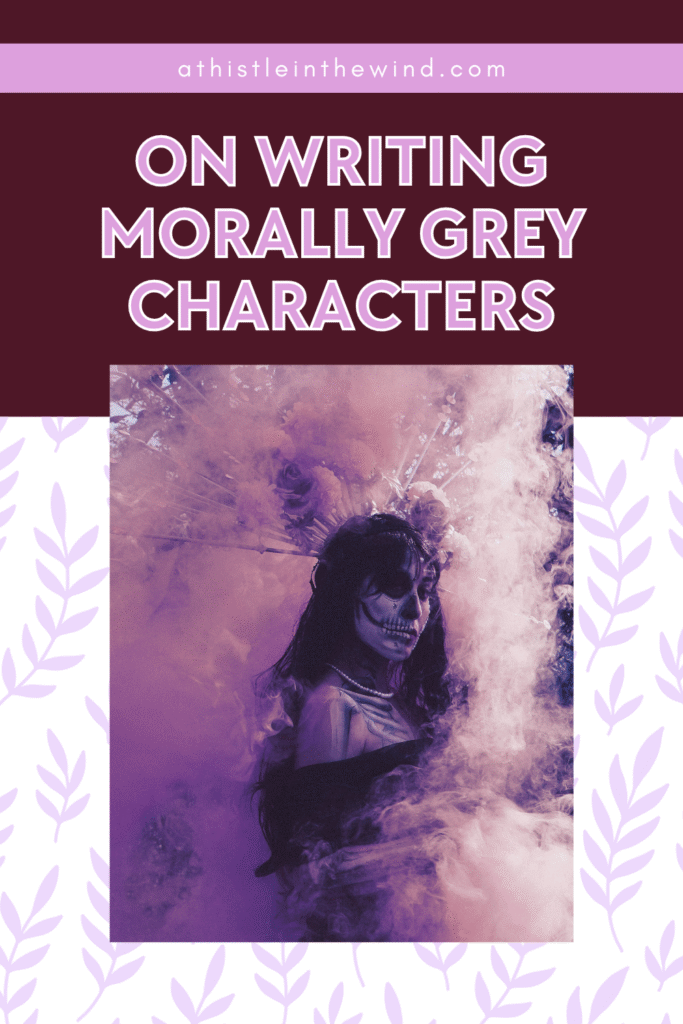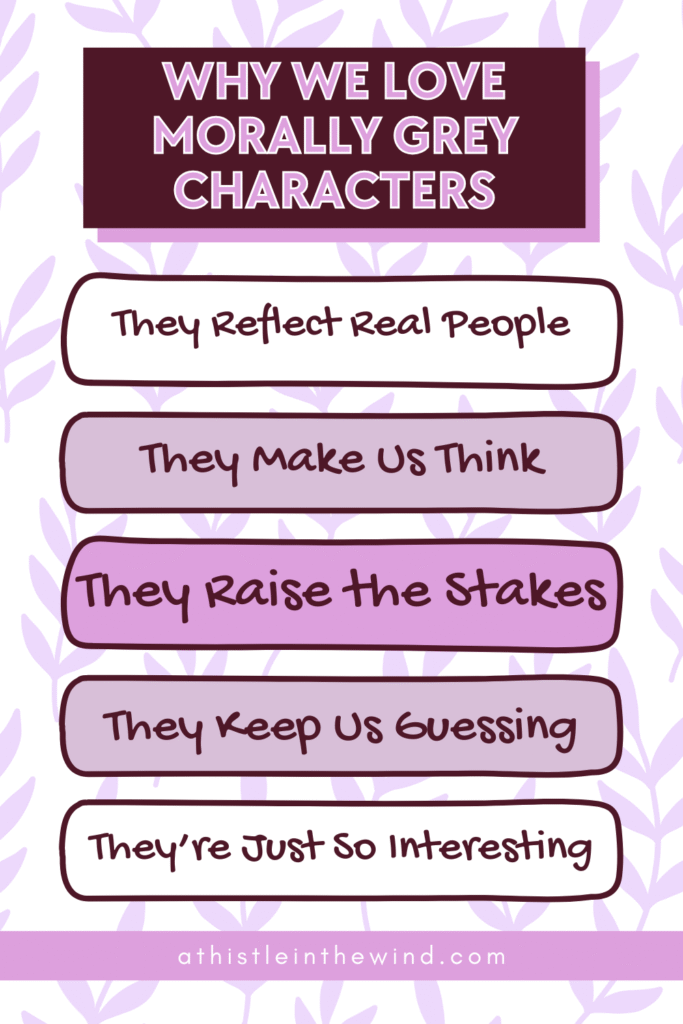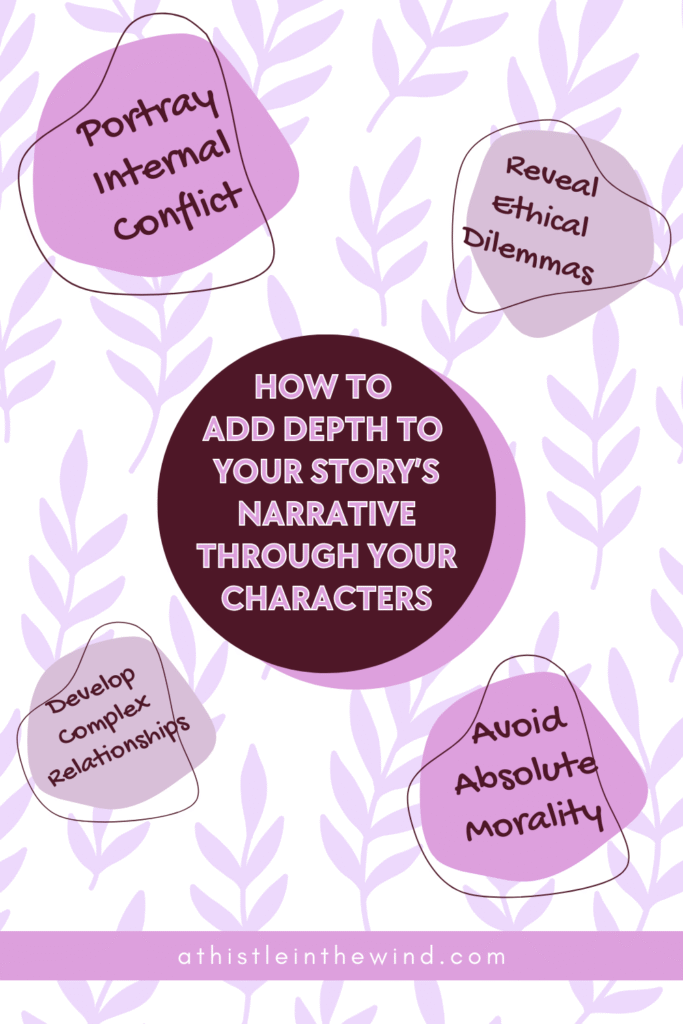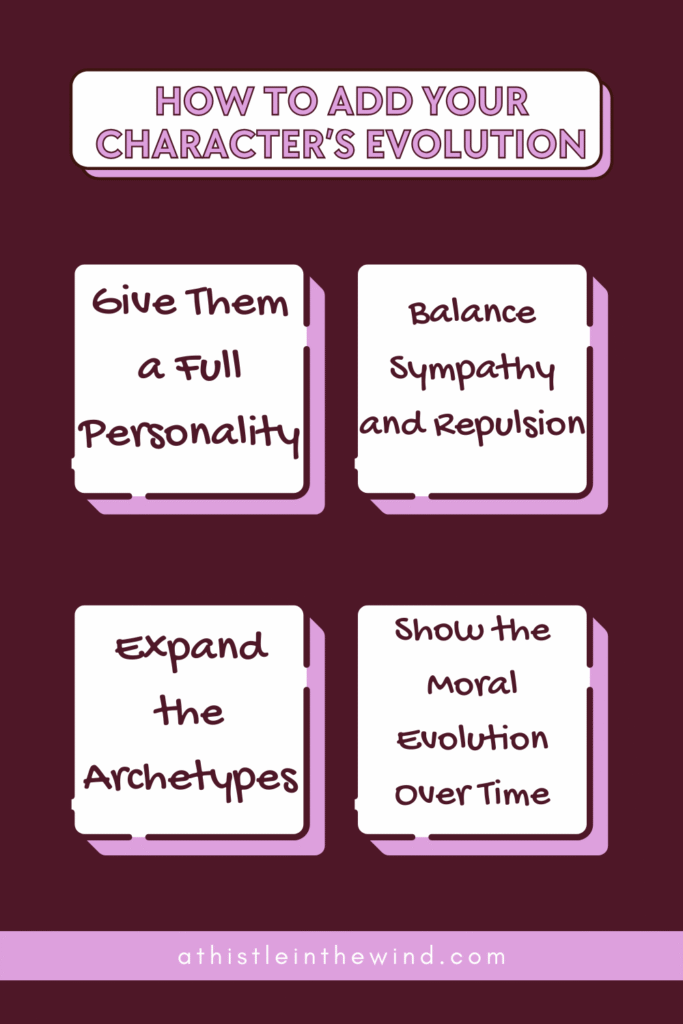On Writing Morally Grey Characters (That Aren’t Just Your Typical Villains or Anti-Heroes)

For the past couple of weeks, I’ve been talking about writing anti-heroes and villains (if you haven’t checked those blogs out, I highly recommend it). So, this week I thought it would only make sense to talk a bit about morally grey characters. Characters who aren’t evil or rebellious on purpose—but still make you uneasy. Or at the very least, question if they’re making the right decision, or make you ask yourself: would I have done anything different?
Think Victoria Neuman from The Boys, or Zuko during the Ba Sing Se arc in Avatar: The Last Airbender.
We’re talking about characters who have the potential to be right, do the right thing, but just…fall short of actually doing it. Characters who are frustrating because they could be the hero if they wanted, could be the villain or the anti-hero, but they’re not committed enough to be any one thing.
What do we do with these characters? How do we write them? If you—like me—are into morally grey characters (in fiction or IRL), this blog’s the one for you. So, without wasting any more time, let’s begin.
First Up, What Is a Morally Grey Character?
Now, I hate pulling this card, but I’ve been reading books a lot lately, and I’ve noticed some things. A lot of writers seem to think that having their characters curse and be Tumblr edgy makes them morally grey.
Yes, I’m looking at Darcey Bell. I recently read A Simple Favour, hoping the book would redeem the horrendous movie, but no. People don’t know what morally grey is, or everyone thinks they’re Stephanie Meyers without the massive Twilight success cred to back it up.
And that’s something you want to avoid. Because let’s be real—it’s hard enough writing complicated stories and trying to get published as a woman (ding. The card lands). I’m not saying it’s oppressive. It’s not. It’s just; I’ve been seeing some of the feedback I get on my short stories and my manuscript. With short stories, fine—that’s just me having fun. But the manuscript—oh, that’s a whole different beast.
And I’m all for equality but some of the comments, that aren’t genre-specific but so clearly want to say the “W” word; oh my god. How are we in 2025?
And then we have the Darcey Bells of the world ruining it even more for the rest of us by writing dumb characters and calling them morally grey. Don’t be like that. So, let’s be specific: what’s a morally grey character?
The Definition
When someone says “morally grey,” they’re not talking about a character who averages out to neutral. So, what do I mean by this?
Well, first of all, it means that you’re not supposed to keep a score card. Just because you have a character who’s, say plotting against the government, doesn’t mean that they also have to have a tragic backstory or volunteer at an animal shelter. Especially if they’re not an anti-hero or villain.
Sometimes, as it is in life, you just have people that are….asymmetric. They might not be the focus of your story, but you don’t want them to be good or bad, just leave it to the reader. I think that’s probably one of the best things you can do as a writer. It lets readers read between the lines, obsess over the implications, try to decipher what’s not said, and that’s how fandoms are made.
Margaret Atwood, George Martin…these guys are great at this stuff.
So, morally grey characters shouldn’t have a balancing act; they can have some redeeming qualities and others that make you second guess them. They might betray someone they love—or protect someone they hate. They’re unpredictable, frustrating, and human. You don’t always know what they’re going to do, but once they act, it makes emotional sense. Maybe not ethical sense. But that’s the point.
Grey ≠ Confused Villain
Another misconception writers and even readers have about these characters are their motivations. That’s why some people might perceive a morally grey character as the villain or the anti-hero, but that’s not always the case.
They’re not confused villains or tortured anti-heroes, they just are. They might not even have a clear goal; they just do what they have to do to survive. And yeah, that’s a good take, but that doesn’t have to be the only motivation they have.
When you’re creating morally grey characters, give them a reason to be the way they are. Childhood trauma, consistent betrayal by those who should’ve protected them, just surviving because of the cards dealt to them…it all adds up. And that’s what makes them interesting to read. They offer a glimpse into real life.
Look, I’m Gen Z—I make chaotic decisions all the time. That doesn’t make me evil, just unpredictable. Which is exactly the vibe you want from a morally grey character. I’m not saying I’m morally grey. So crank up the chaos and make them lovable or loathsome—or both.
Why We Love Morally Grey Characters
I know, the last line? Perfect segway into this section. So, now in case you’re still confused (and that’s fine, morally grey characters are confusing), let’s look at what draws readers to these characters.
1. They Reflect Real People
Let’s be honest, we’re not walking around being paragons of goodness all day. Especially in this economy. We’re making choices based on survival, pettiness, stress, love, trauma, or just straight-up convenience.
Morally grey characters feel like people you know—or maybe people you’ve been. They’re not trying to be good or bad. They’re just trying to be. And that hits.
2. They Make Us Think
One of the best things about morally grey characters is how much they unsettle us. They make us pause and go, “Wait… were they wrong, though?”
Or worse: “Would I have done the same thing in their place?”
They poke holes in the moral compass and force us to rethink what we believe about justice, loyalty, love, and power. Which is exactly what great stories should do.
3. They Raise the Stakes
Here’s the thing with grey characters: you genuinely don’t know what they’re going to choose. They could save the world or burn it down, and both would make sense for them. That unpredictability adds tension to every scene they’re in. You have to keep reading, just to find out which side they’ll tip toward next.
4. They Keep Us Guessing
Unlike heroes who follow a code or villains with a clear agenda, morally grey characters don’t play by the same rules. They lie, they improvise, they backtrack.
You think you’ve figured them out—and then boom, they do something completely unexpected and painfully human. And that’s kind of the thrill, isn’t it?
5. They’re Just So Damn Interesting
Yep, I couldn’t come up with another point but it’s true. Morally grey characters are just more fun to write and read. They let you explore complex questions without being preachy.
They’re witty, layered, and often come with excellent trauma-based one-liners. You’ll remember them long after you’ve forgotten the name of the hero who “did the right thing.

How to Write a Morally Grey Character
We’ve already taken a look at what morally grey characters are. Now it’s time to actually write them. So, here are some practical steps and deeper considerations you should take as a writer to write better characters.
The Core Elements of Your Character
Okay, so first up—FYI, this bit isn’t necessarily for morally grey characters. When I’m creating characters, this is something I do for everyone: whether they’re the good guys or the bad ones.
But what it does is that it helps you understand your character. Create individual plots for them regardless of who they are and how big or small their role is.
Think of the core elements of your characters as the foundational framework. And how do you do that? Well, there’s a few ways you can start.
1. Start with their Purpose
In fiction and real life, people need a driving force. It’s the reason behind what you do on a daily basis, whether it’s short term or long term. This is especially important for your morally grey characters.
Clearly identify what your character wants to achieve and, crucially, why they want it. Their goals don’t have to be altruistic; in fact, they’re probably very selfish but they must remain logical and understandable.
Readers should be able to grasp the reasoning behind their desires, even if they disagree with the aims or methods. This clarity provides a vital anchor for their actions.
2. Give Them a Backstory
Once you’ve given them a purpose, now you need to create circumstances that led to or cemented this purpose. That’s where their backstory comes into play. And this is extremely important. As the writer, you can choose how much of their past you want to reveal to the reader; in fact, if you want, you can totally only drop hints, letting the reader fill in the gaps.
Go deep into experiences like personal traumas, societal influences, or pivotal moments that forced ethical compromises. An effective backstory isn’t just a ‘sob story’; it’s an authentic narrative that genuinely reshaped their worldview.
3. Establish their Moral Framework
If you’re into flawed characters, you’ll know that morality is relative. So, for your character to appear truly morally dubious, you’ll need to define the ethical rules and societal norms of your world first.
It’s only after you’ve done this that you can explore how your character navigates these spaces. Seriously, just being “edgy” by talking smack or being “so random” by doing something ridiculous in serious situations (think that Libby song from a certain book series) doesn’t make your characters morally ambiguous or cool.
They will likely operate in the ambiguous spaces, challenging simplistic notions of good versus evil. Every character also possesses their own unique moral compass, influenced by life experiences such as social class, career, or upbringing. Exploring these varied perspectives enriches your storytelling, leading to thought-provoking narratives.

Weave the Foundations into Your Story’s Narrative
Once the foundations are set, next you need to bring your morally grey character to life through their interactions, decisions, and internal struggles. This is where you show, not tell, and there are certain ways you can do this.
1. Portray Internal Conflict
A key way to show compelling morally grey characters is through their inherent internal struggle. They shouldn’t always act with unwavering conviction. Instead, they should frequently question their choices and grapple with repercussions.
Displaying a mix of guilt, remorse, and justification adds profound depth, showcasing the ongoing battle between their virtues and flaws. True complexity stems from these difficult questions and internal conflicts, not just from brooding.
2. Reveal Ethical Dilemmas
To highlight their ambiguity, place your character in situations demanding difficult choices. These aren’t simple good-versus-bad scenarios, but complex ethical dilemmas where every option carries significant moral weight.
How they make these choices, and critically, how they feel afterward, reveals the nuances of their moral compass. Do they struggle, or act without hesitation? Their grappling with having crossed certain lines makes them truly intriguing, inviting readers to ponder the complexity of such decisions.
3. Develop Challenging and Complex Relationships
No character exists in isolation. Your morally grey character’s choices inevitably impact others. Develop relationships that actively test their moral ambiguity. These interactions compel them to confront beliefs, question methods, or face direct repercussions.
Other characters can serve as mirrors, reflecting different perspectives and pushing your morally grey figure towards self-reflection and evolution. These relationships are vital for both plot development and demonstrating the character’s internal journey.
4. Avoid Absolute Morality
Avoid portraying morally grey characters as mere villains with redeeming qualities or heroes with minor flaws. To maintain true ambiguity, ensure their actions reflect a genuine mix of both good and bad intentions.
Their decisions should not always yield clear moral outcomes. Just because they cross lines for a perceived noble cause doesn’t mean the choice is justified or consequence-free. Their inherent greyness lies in choices that are sometimes justifiable and sometimes not, creating unpredictable complexity that keeps readers engaged.

Add Your Character’s Evolution Throughout the Story
Morally grey characters are rarely static, and their journey often involves significant internal shifts and growth. Here’s how you can do this.
1. Give Them a Full Personality
Don’t limit your morally grey characters to angst or ruthlessness. For a richer figure, allow them to display a wide range of personalities and emotions. Show moments of joy, humour, vulnerability, anger, and tenderness, as appropriate for your story.
A character solely defined by being ‘broody and tortured’ lacks the depth that makes moral ambiguity fascinating. Reveal their full selves and unique facets.
2. Balance Sympathy and Repulsion
The most resonant morally grey characters are those with whom readers can empathise, even when disagreeing with their actions. Simultaneously, it’s vital to depict the genuine consequences of their morally ambiguous choices, keeping them grounded and relatable.
This delicate balance between sympathy and, at times, repulsion creates a compelling experience, forcing readers to confront their own moral compasses and see the shades of grey within us all.
3. Expand the Archetypes
While many morally grey characters fit the antihero archetype, they don’t have to be limited to this archetype. Their moral ambiguity can manifest in diverse ways, beyond heroic-but-dubious deeds.
Explore different motivations and expressions of their greyness. This broadens character possibilities, allowing you to create truly unique and unexpected figures that subvert typical expectations.
4. Show the Moral Evolution Over Time
Your morally grey character should not remain stagnant. Allow their experiences and interactions to shape their morality over time. They may grow, regress, or fundamentally change as they face consequences and witness both positive and negative outcomes of their decisions.
This evolution adds dynamism and realism, mirroring how real people adapt throughout their lives. Consider how enduring hardships or achieving triumphs might alter their perspectives and moral boundaries.

Don’t Be Afraid to Make Things Complicated
At the end of the day, your morally grey characters need to be complicated, entertaining and completely human. As I’ve said before, these characters force us to wrestle with what’s right, what’s necessary, and what’s human. And when done well, they leave a mark—not because they were perfect, but because they weren’t.
So don’t flatten your characters into tropes. Don’t wrap them in convenient moral bows. Let them be confusing. Let them be infuriating. Let them be real.
Because when your reader puts the book down, they won’t remember the flawless speeches or the perfectly executed plot twist. They’ll remember that one character—the one who lied when they should’ve confessed, who saved the villain but hurt their friend, who made them whisper:
“God, I hated them. I miss them already.”
That’s the power of grey. Use it well.
Interested in learning more characters and how to write them? Check out these blogs:

16 Comments
Donnie
When it comes to characters that don’t fit the hero/villain binary, this post nails it. The examples were especially useful. I’d love to see more dialogue-focused posts next!
Walter
Really appreciated the breakdown on writing morally grey characters!
Paula
Great read!
Pheobe
This was very insightful! Thank you!
Konnie
Thak you for your guide! This was very helpful:)
Stanley R.
I’ve read your anti-hero and villain articles too. This one reminds me of a lot of Game of Thrones characters like Littlefinger and Vars.
Sura
tbh I do think that Vars might be a morally grey character; Littlefinger on the other hand…not as great as he thinks he is!
Jennie
I never thought of my villains as morally grey characters. This villain in my book that I want to make likeable. I think I’ll just make him a morally grey character insteadQ
Raz
this was detailed. thank you
Gracie Regges
I like these kinds of characters. They’re fun to write
Christie Stanochi
This was a great read! Thanks
Razel
I love the examples you give here!
Sally C.
Morally grey characters, love the sound of that!
Drew Smith
Nicely done. Thank you
Erika T.
I would love to know more about what you have more to say on this subject!
Matty McGill
Great attention to detail!